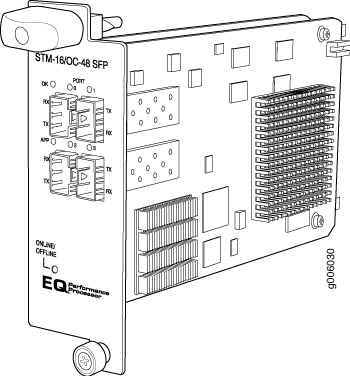Software release
|
|
Description
|
Four OC48/STM16 ports
Clear channel functionality
SONET and SDH is configured on a per-port granularity
Power requirement: 1.06 A @ 48 V (51 W)
Weight: 1.6 lb (0.725 kg)
Model number: PC-4OC48-STM16-IQE-SFP
|
Hardware features
|
|
Software features
|
Quality of service (QoS) per channel: weighted round-robin
(WRR), random early detection (RED), weighted random early detection
(WRED)
Fine-grained egress queuing per logical interface. See
the Junos OS Class of Service User Guide for Routing Devices for more information about class-of-service
features
Packet buffering
Local line and remote payload loopback testing
Optical diagnostics and monitoring
Clocking options: internal or external/loop mode. Each
OC48 transmitter port is configured either in internal or external
mode. The default clocking option is internal mode.
Encapsulations:
Extended Frame Relay for circuit cross-connect (CCC) and
translational cross-connect (TCC)
Flexible Frame Relay
Frame Relay
Frame Relay for CCC
Frame Relay for TCC
Frame Relay port CCC
High-Level Data Link Control (HDLC)
HDLC framing for CCC
HDLC framing for TCC
MPLS CCC
MPLS TCC
Point-to-Point Protocol (PPP)
PPP for CCC
PPP for TCC
|
Cables and connectors
|
Tip: You
can use the Hardware
Compatibility Tool to find information about the pluggable
transceivers supported on your Juniper Networks device.
The list of supported transceivers for the MX Series is located
at https://pathfinder.juniper.net/hct/category/#catKey=100001&modelType;=All&pf;=MX+Series.
Note: To extend the life of the laser, when a PIC is not being
actively used with any valid links, take the PIC offline until you
are ready to establish a link to another device. For information about
taking a PIC offline, see the request chassis pic offline command in the CLI Explorer.
|
LEDs
|
OK LED, one tricolor:
Off—PIC is offline and safe to remove from the router
Green—PIC is operating normally
Yellow—PIC is initializing
Red—PIC has an error or failure
APP LED, one green per port:
Port LEDs, one tricolor per port:
Off—Not enabled
Green—Online with no alarms or failures
Yellow—Online with alarms for remote failures
Red—Active with a local alarm; router has detected
a failure
|
Alarms, errors, and events
|
SONET alarms:
Loss of light (LOL)
Phase lock loop (PLL)
Loss of frame (LOF)
Loss of signal (LOS)
Severely errored frame (SEF)
Alarm indicator signal—line (AIS-L)
Alarm indicator signal—path (AIS-P)
Loss of pointer (LOP)
Bit error rate—signal degrade (BERR-SD)
Bit error rate—signal fail (BERR-SF)
Remote defect indicator—line (RDI-L)
Remote defect indicator—path (RDI-P)
Remote error indicator (REI)
Unequipped (UNEQ)
Payload label mismatch—path (PLM-P)
SDH alarms:
Loss of light (LOL)
Phase lock loop (PLL)
Loss of frame (LOF)
Loss of signal (LOS)
Severely errored frame (SEF)
Multiplex-section alarm indicator signal (MS-AIS)
H Path alarm indicator signal (HP-AIS)
Loss of pointer (LOP)
Bit error rate—signal degrade (BERR-SD)
Bit error rate—signal fail (BERR-SF)
Multiplex section—far end receive failure (MS-FERF)
High order path—far end receive failure (HP-FERF)
Remote error indicator (REI)
Unequipped (UNEQ)
High order path—payload label mismatch - Path (HP-PLM)
Optical diagnostics related alarms:
Note: Transceivers from some vendors do not support these fields.
Temperature high/low alarms and warnings
Supply voltage high/low alarms and warnings
Tx bias current high/low alarms and warnings
Tx output power high/low alarms and warnings
Rx received power high/low alarms and warnings
|

